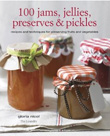MY CHRISTMAS PIE FOR VEGETARIANS
Friday December 23rd 2011, 11:57 am

I just remembered this partially prepared blog post from a few months ago and thought it appropriate to finish it. At the time I was gathering mushrooms from the field by my house and it had reminded me of my favourite mushroom pie recipe that I have made many many times. The recipe comes from a book from 1972, Cookbook For The New Age, Earth Water Fire Air by Barbara Freidlander. When given to me, I’d just decided to become vegetarian, had married at a ridiculously young age and was starting out learning about life and food and cooking. I have made this pie and variations of it on so many occasions and it has been served as part of Christmas lunch many times as well, which is why I’m publishing it now, in case you are looking for some last-minute inspiration.
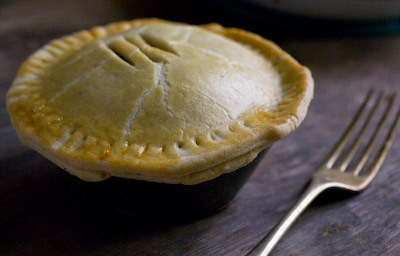
I’m not so pleased with my pictures here but it is the recipe that is important on this occasion. The book is American so is written in cups and pounds, which at the time was very peculiar and exciting for me to translate. I’m going to copy it as is and for the sake of speed have no intentions of adding the metric conversion this time round, but hope you’ll get the gist and feel inspired anyway. More often than not I’ve used hazelnuts in place of the cashews and usually toast them lightly first.
MUSHROOM PIE
Makes 1 large or 2 small pies
CRUST
2 cup pastry flour
1/4 tsp salt
1/4 pound butter
1/4 cup cold milk
FILLING
1 pound mushrooms, sliced
5 celery stalks, chopped
1 small onion, chopped
1/4 cup unsalted cashew nuts, chopped
pinch of thyme
salt and pepper to taste
4Tbsp butter
Cream sauce **
Make the pastry in the usual way (rub the butter into the flour and salt then add the milk and bring it together to form a ball). Leave in fridge to chill whilst the filling is prepared.
Saute the first 6 filling ingredients together in 4Tbsp butter, cover and cook until the mushrooms are tender. If there seems to be lots of liquid from the mushrooms, cook for a while without the lid to help it evaporate.
Meanwhile in another pan make the cream sauce** Combine the sauce and mushroom mixture and blend well. Check the seasoning and adjust at this point. Preheat oven to 400F 200C Mk6.
Cut the pastry dough into 2 pieces, one slightly smaller for the pie lid than the other for the base. Roll out the pastry on a floured board for the base and line a greased pie tin. Pour/spoon in the filling. Roll out the pastry lid, cut a few slits in the centre, brush the base edges with milk or water and lay the lid in place sealing the edges. Brush the top with milk or beaten egg to glaze. Place in the oven, reduce the temperature to 350F 180C Mk4 and bake for 40-45 minutes till nicely golden.
** CREAM SAUCE
2Tbsp butter
2Tbsp flour
1/2 cup milk
salt and pepper
freshly grated nutmeg
Melt the butter in a pan over low heat, add the flour and stir to form a roux. Gradually add the milk, stirring between each addition to make a smooth sauce. Let it cook for a few minutes then season. For the pie the sauce can be quite thick as the mushroom mixture will make it thinner.

HIGH HOPES FOR AN EGGY FUTURE
Saturday May 21st 2011, 2:03 pm

There is much excitement close to home, as me and next door are about to collaborate on our first chicken keeping venture. We have placed our order for 5 orpingtons; 2 lavenders, 2 buffs and a lavender cockerel, and will be taking delivery in a couple of weeks time. We can’t expect any eggs from them until around November time but most importantly – the names have been chosen. As I’ve never kept chickens before I’ve begun to swat up on them. I do know people who keep chickens, so suspect it isn’t too difficult and can already see which way this new interest is likely to go as even at this early stage we have started to discuss other breeds we might like and what colours of eggs they will hopefully produce.
In the meantime, I bought my first book on the subject; Hens in the Garden Eggs in the Kitchen by Charlotte Popescu. I’ve collected several other books of hers and can really recommend them. As well as chicken keeping, she writes about other subjects close to my heart, from wild fruits and apples to vegetable gardening and bee keeping. They are all small paperback books packed with useful information and recipes presented in a very simple and modest way.
In my new hen book she gives this really useful guidance about the freshness of eggs, particularly relevant to those people who know exactly when their eggs are laid. If you are buying shop bought you’ll just have to guess I’m afraid.
Your eggs need to be as fresh as possible if you want fried or poached eggs. For boiled eggs that you wish to peel, it is best to use eggs that are about a week old as the shell and skin are really difficult to peel off on fresh eggs. ….
If you are scrambling your eggs or making an omelette, eggs can be up to a week old. For baked dishes, eggs can be older than a week. If you want to separate the yolks and the whites to make meringues, eggs are best a few days old as the whites whisk up better if not too fresh.
Pickled eggs have never interested me until I came across a recipe for Pickled Huevos Haminados in another lucky find, The Mediterrannean Pantry by Aglaia Kremezi, published 1994. As soon as I read the recipe I knew I had to make it, though haven’t done so yet. I’m actually growing the red onions at the moment, which is, I suppose, beyond the call of duty. I have found the recipe online here if you fancy having a go and beating me too it. I’ll be tempted to serve a pickled egg with some asparagus spears pickled earlier.
This week I’ve been trying to make some room in the freezer before the berry season kicks off. I’m not a big fan of freezing as mine works on an ‘out of sight out of mind’ principle. I tend to forget what’s in there, all the while those ingredients are racking up additional running costs! (This year I’ll be canning fruit in jars as much as I possible.) I used a tub of blackberry puree, picked and prepared last August, and rustled up 4 pots of blackberry curd, which is a delicious way of using up eggs. A spoonful or two of fruit curd swirled through some Greek yoghurt is fabulous, or you can use it as the filling in a simple sponge cake or dollop on meringues (making use of even more eggs).
Oh yes, I’ve got eggs on the brain and this is only the beginning.
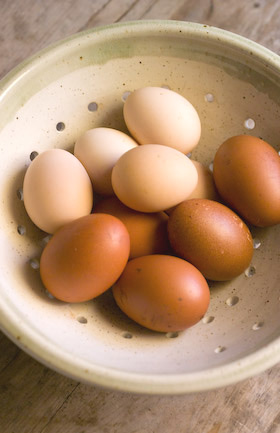
JAM JARS & MARMITE
Monday February 28th 2011, 2:27 pm

This is supposed to be a quick one, but in true geek style has become something more. Inspired by Kerstin Rodger aka MsMarmiteLover trailblazer and proprietor of the first underground supper club in the UK, whose blog post at The English can Cook about her love of jars and forthcoming supper club event this Friday Jar Food – Pickles, Potions and Preserves , got me thinking about …. jars. Seemed like a quick blog post to gather some of my favourite jars together, without it becoming some big deal would be a possibility. Trouble is, that when the differences in ridges on glass are something you admire, you get sort of, caught up. Anyway, here are just a few from my collection and I hope you enjoy them as much as I do.
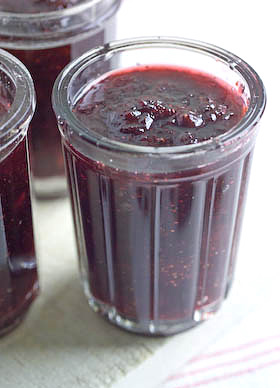
Vintage French jam jars are such classics and feature plenty of ridges and facets in all sorts of variations. A good heavy handful and chunky lipped edge are what you want. A few nibbles around the top are OK too. You can always use them as candle holders and vases if you don’t have any confiture to fill them with. I will be selling some of my vintage French jam jars at the Selvedge Spring Fair on the 2nd April in London. Follow link for more info.

When I wrote Fruits of The Earth my preserving book, (sorry currently out of print but will be available again in paperback in June) the publisher asked me to use some Ball jars, to suit the American market. They are virtually impossible to buy here in the UK but by one means or another, I’ve acquired a few along the way. These vintage ones in beautiful turquoise glass look great when used as vases.
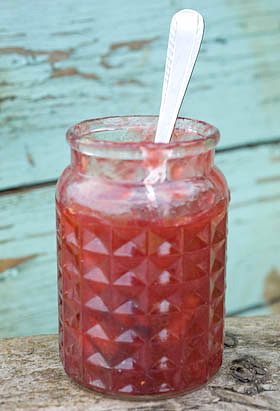
I always look out for interesting shaped jars and my vintage English Wye Valley Preserves jars (I’ve got 2 of them) are real favourites. They just wouldn’t make them like that these days. Finding them was sheer fluke, so sorry no tips on where to look. Just keep your eyes peeled.
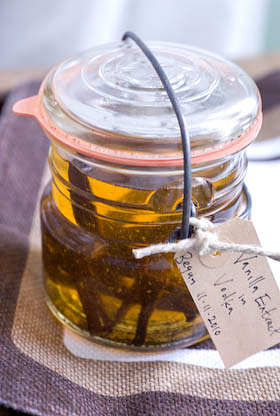
Another Ball canning jar, this time with wire bale clip top. These aren’t recommended any more for canning but people do still use them. Finding new rubber seals is the problem. See the brilliant Food in Jars for more info about this.
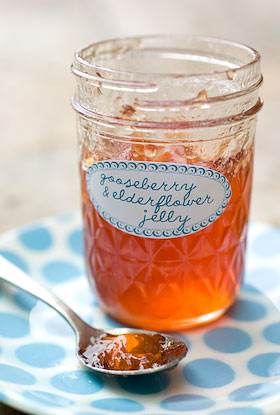
I love Ball quilted jelly jars and again you can’t buy them in the UK. My friend Chris brought me 2 back from the US a while ago and I use them repeatedly. They are so cute and worth looking out for if you are in the States.
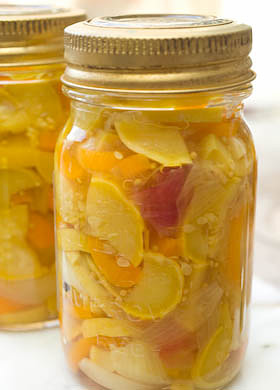
I’ve been given quite a few old Kilner jars by people. Often I’m given them because their owners think them now redundant but in fact you can still buy replacement seals for them. Peter Denyer at The Kilner Jar knows everything there is to know about Kilner jars, sells the seals and also reconditions the rusty tops. A real niche business. These Kilner Improved jars are great because they have a glass lid. For canning, there is something really satisfying about only natural materials, glass and natural rubber, being used here. Look out for old jars on your local Freecycle.
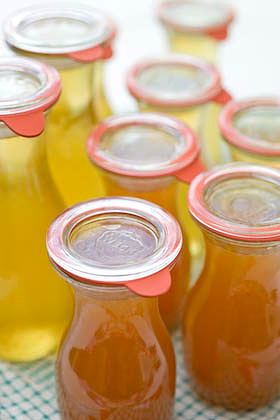
Weck jars and flasks have such simple lines and are great for the modern pantry. Again, just glass and rubber used here and they work so reliably. I’m a big fan of canning cordials and syrups and find the 1/4 and 1/2 litre size flasks most useful. Weck jars are really easy to open as you simply pull the rubber tongue to release the seal. Also seals are reusable.
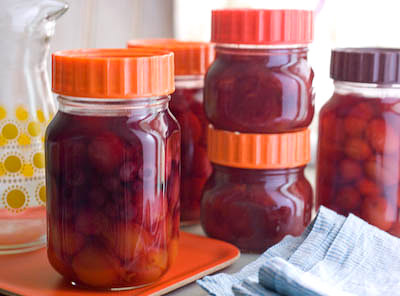
With great 70’s style, these vintage Ravenhead Kilner jars are another favourite that I use a lot. The screw bands were made in orange, red and brown plastic, and also white apparently, but I’ve never seen one of them. Again try The Kilner Jar for replacement seals. The last canned jar I tried to open was so well sealed that I had to email Peter Denyer for advice on how to prize off the lid. In true expert fashion, he told me to carefully slide a knife under the seal and gently lever. You have to be careful when doing this as chipped edges can totally ruin a canning jar and make it unusable.
Kerstin’s Jar Food supper club is one NOT to be missed. Also her book Supper Club – Recipes and Notes from The Underground Restaurant is available to pre order on Amazon and will be published at the end of March.
BOTTLING TOMATOES & THE ACIDITY CUSP
Monday August 16th 2010, 1:05 pm
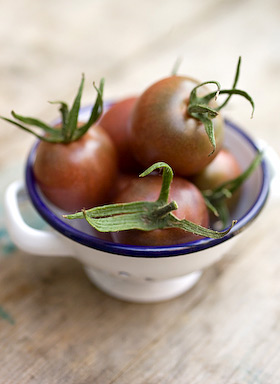
Month eight Tigress’s can jam canning challenge and for August the ingredient chosen by the inspired and inspiring Julia is tomatoes. My relationship with this ubiquitous fruit has been a checkered one. I hated tomatoes as a kid but learnt to tolerate them later on. I do like them as a sauce for pizza, applied with a lightness of touch though. I can now eat cherry tomatoes raw and, like biting into any fruit, appreciate their sweetness so I suppose you could say I’ve made progress.
But it is as objects of beauty that tomatoes especially come into their own. The resurgence of interest in growing heritage varieties has brought all these wonderfully coloured tomatoes to the fore; striped, heart and pear shaped, shaded like a shop display of lipsticks, from gold to chocolate. They are all so fantastically photogenic and worth growing for looks alone.
As an ingredient for canning, they are on the acidity cusp. Tomatoes require special attention for bottling safely using the water processing method or else should be pressure canned. They are only just on the acid side of neutral and acidity can vary for different varieties, so it is necessary to add a little more acidity in the form of lemon juice or citric acid to make sure they stay safely putt. It is important that time spent preserving has a very definite pay off later so it makes sense for me to bottle really useful tomato passata-type sauces for cooking up further down the line into pizza toppings, pasta sauces or as additions to winter casseroles.
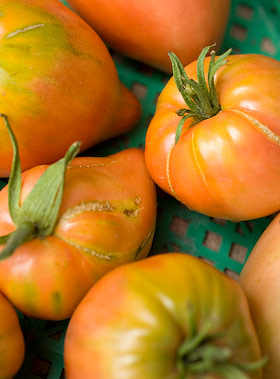
Each year I begin the growing season with high hopes for an extensive range of weird and wonderful tomato varieties. I don’t have a greenhouse so can only grow toms out in the open. We’ve had two consecutive years of blight bringing these plans to a soggy and disappointingly diseased halt, but this year the weather has been kinder. Tinned tomatoes are as cheap as chips, so I don’t think it is really cost effective to bottle tomatoes unless you have your own homegrown supply or you are able to mop up someone elses glut. The plants I have growing in the garden are still some way from the ‘glut’ stage. Thankfully my neighbour Jane has a greenhouse as well as green fingers. She sells her excess garden produce from her garden wall. Last week I picked up four generous punnets of yellow and red tomatoes from the wall and dropped my payment into the honesty box provided.
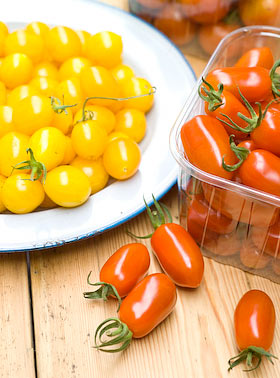
So first a basic tomato sauce. These cherry tomato varieties are as sweet as anything though perhaps not the most ideal kinds for bottling. For sauces, larger fleshy varieties like Roma and San Marzano are good. Skinning so many tiny fruits was definitely out of the question for starters. Tomatoes can be very watery, which means that they will require considerable cooking to reduce, thicken and intensify the flavour, unless some of the liquid is removed first.
In order to give a fresher flavoured result with less cooking time I began by slitting each fruit and removing the seeds by running my thumb quickly through their middles, collecting the seeds in a sieve placed over a bowl. Any collected juice would come in handy later. After a brief cooking time of 10 minutes the de-seeded tomatoes were then processed using a passata mill, running it through several times to separate the skins from the pulp. The passata mill is a bit of kit I acquired some years ago when dreaming of a bounteous tomato crop that never materialised. The mill has sat unused in its box ever since so this was its first opportunity to prove its worth. I must say that I wasn’t too impressed. Passata-ing the tomatoes was a messy and annoying business (compounded by trying to take photographs at the same time). Tomato juice splattered all over the place and possibly it was my fault, but juice was squirting out the handle side as well! Next time I will most likely use my regular food mill over a bowl, which though still requiring patience would be less messy and more controllable. Depending on the scale of the project, to remove skins and any stray seeds you could simply push the tomatoes through a sieve if you prefer. Still too watery for my liking, I strained the flesh again briefly in a sieve collecting more juice to add to what had been collected earlier. 2.5Kg (5 1/2lbs) of tomatoes resulted in 775g (1 3/4lbs) puree and 750ml (1.3 pts) of juice.
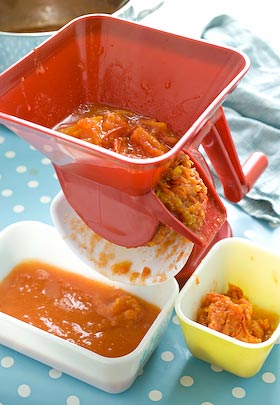
HOW TO BOTTLE TOMATO PUREE
Prepare the water bath, jars and seals ready for bottling (canning). For more info about how to hot water process, refer to the guide here.
Put the pureed tomatoes in a pan and simmer for a short time to reach a consistency that suits you so excess juice has evaporated. If the puree is already thick enough simply bring to boiling point. I added 1 tsp sea salt (a non essential, so add salt to own taste or leave out all together) plus an aditional acidic booster. As a general guide you need to add one of the following to every 500ml (1 pt) tomato puree: 1Tbsp lemon juice or 1/4 tsp citric acid. I used balsamic vinegar instead, adding 2 Tbsp balsamic vinegar per 500ml (1pt) puree.
Place a basil leaf inside each jar against the glass and fill jars with tomato, leaving headspace required for your type of jar. Remove bubbles from sides of jars using a small spatula, wipe rims clean and seal. Process 500ml (1 pt) jars for 35 mins and 1ltr (quart) jars for 45 mins. Remove jars from water bath and leave till cold before testing the seals. Any jars with loose seals will require reprocessing or you can keep them in the fridge for using up within a few days. Remember to label all your jars before storing them.
My tomatoes made 2 x 350g (12oz) jars of sauce plus a bit more that I had with pasta for my dinner that evening.
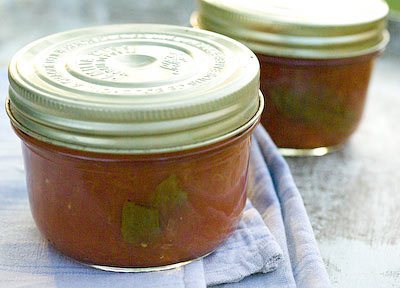
WHAT TO DO WITH THE JUICE
It seemed a shame to waste the lovely sweet juice collected whilst extracting the tomato puree, so I decided to turn it into tomato jelly. You could flavour tomato jelly with fresh ginger and ground coriander or finely chopped chilli. After much deliberation I eventually chose vanilla and white pepper for a jelly with a sweet / savoury crossover. This jelly is delicious on sourdough toast with cream cheese and I used it to fill tiny savoury pastry cases, topped with sour cream or crumbled goats cheese for a really exquisite little mouthful.
As tomato juice is lacking in pectin, a boost in the form of the addition of lemon or apple juice is helpful. Having bottled some whitecurrant juice several weeks earlier to use at times like this, I added some of that for its setting quality. Preserving sugar containing added pectin could also be employed here. Adjust proportions to suit what you have available.
TOMATO, VANILLA AND WHITE PEPPER JELLY
750ml (1.3 pts) tomato juice (a byproduct of making the puree above)
550g (1 1/4lb) sugar
Juice of 1 lemon or 150ml (2/3 cup) whitecurrant juice
1 vanilla pod, split and seeds scraped from inside
1/2 tsp ground white pepper
Prepare the water bath, jars and seals ready for canning. For more info about how to hot water process, refer to the guide here.
Pour the juice through a jelly bag, collecting the juice in a measuring jug. To every 600ml (1 pt) juice add 450g (1 lb sugar). Place all the ingredients in a preserving pan. Stir constantly over low heat until the sugar has dissolved then turn the heat up to bring to a rolling boil. Boil to setting point, (it took me about 10 minutes) when a blob of syrup on a cold plate will formed a skin when you push your finger over the top of it. If using a jam thermometer it will register 220F 105C. Remove the vanilla pod and fill hot jars, leaving the required headroom for their type. De-bubble the sides using a small spatula or chopstick, wipe jar rims clean, before sealing and placing in the hot water bath. Process for 10 minutes, remove from the bath, then leave till cold before testing the seals. Label and store.
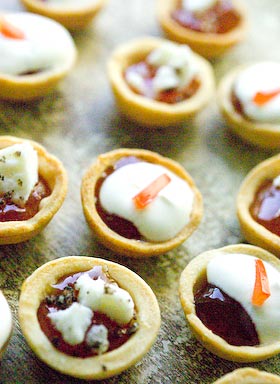
The ratio of sugar to juice is the classic one used when making jellies. This jelly is very nice indeed but I will be tempted to cut down on the amount of sugar when I make this next. It is often safe to keep jams and jellies without hot water processing (canning) them. If you do can them you are making doubly certain that they will be preserved safely for a year or even longer.
EVERYBODY MUST GET STONED
Friday September 11th 2009, 4:55 pm
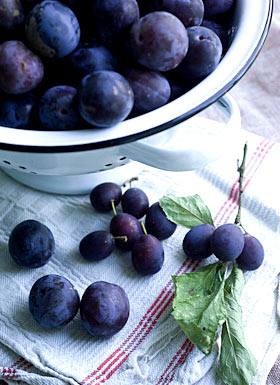
I’m down to my last colander full of damsons. They need using up in the next day or two, otherwise they’ll be over and done with and I hate to waste any of this glorious fruit. I’ve made half a dozen jars of damson chutney, which is already pretty fantastic (if I say so myself) even without its mellowing off period of at least 6 weeks and there’s now several containers full of fruit in the freezer, cooked and stoned to use later.
I always remove the stones from damsons even though it very quickly becomes an arduous job, but it is so worth it after the event. I’ve had several evening sessions of filching these tiny stones out of the cooked fruit by hand, with the pan on my lap whilst watching tv. Here’s a tip; before you plunge your scrupulously clean hands into the pan of squidgy fruity mush, be sure you have chosen your tv channel. The other night I had to decide whether to abandon the stoning in order to get cleaned up to switch channels, or to watch Rambo. I ended up watching an hour of Rambo.
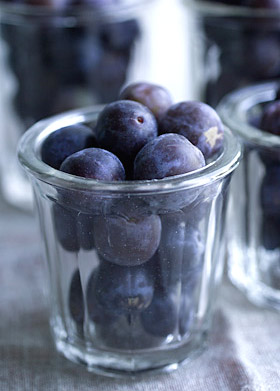
I need to start some damson gin, so some of the remaining damsons are designated for that. The other day I donated some 2 year old damson gin to my neighbour Steve, to include as part of a hamper he was making up for a friend’s wedding gift. I love to make these things, then don’t get round to drinking them. The deal was that he’d replace the gin so I could start off another batch.
I never bother straining the matured gin off the fruit so wasn’t sure whether this would have had a detrimental effect on the taste. We decided we had better sample it first to be on the safe side, so the two of us stood in his kitchen, sipping and savouring, to see if it would pass muster and discussing the finer points of the flavour. It was like a heavenly nectar with just the slightest hint of almond, which was very lovely indeed. As is the way with fruit containing stones, such as apricots, peaches, cherries and plums, the kernels do have this almondy vibe, and damson stones left to steep in gin for any length of time will likewise imbue this flavour.
In Jane Grigson’s Fruit Book she includes a recipe for Plum Stone Noyeau, a flavouring to use for puddings and cakes made before the advent of almond essence. Basically you steep cracked plum kernels in eau de vie or vodka for several months. I intend to give this a go using my discarded damson stones, though bruising and cracking them with a hammer could prove a particularly dangerous occupation.
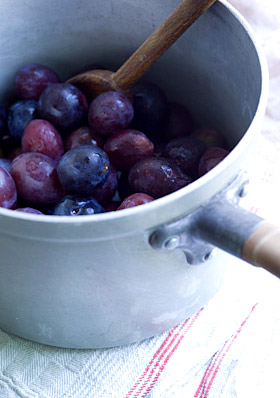
IT’S SHOW TIME
Sunday August 16th 2009, 4:00 pm

The village fruit and veg show is only 2 weeks away, so I need to get my skates on. Last year I managed a 3rd prize for my crab apple jelly and a second prize for my damson chutney and I would love to do better this time round. As my book came out earlier this year, I now feel I have my reputation as well as fruit to preserve.
The blackberries round here are particularly plump and abundant this year. Last year I did manage to gather some but each berry was small with not a lot of juice. This year it is a very different matter. Yesterday evening I went out to pick some, along with my cat Beau. He wasn’t any help but did bring a certain cute factor to the proceedings. I managed to harvest a large plastic box full in a very short time and as it is still early in the season, I know there will be lots more fruit to come over the next few weeks.
The plan, to make blackberry and nectarine jam, as I picked up some nectarines in the supermarket this week, reduced with yellow labels! (I have become the yellow label queen). I made this preserve for the book and it was a great success. In the recipe it does have added spices in the form of star anise, cloves and cinnamon, but I’m going to forgo the spiced approach and hope the fruit flavours are tasty enough to stand alone. I do love using nectarines in jams as they have a lovely acidic flavour.
There are elderberries almost ready to pick here, so blackberry and elderberry jam is the next jam I’m planning. I love the idea of using two foraged-for-free fruits together.
Plum and elderberry, again there are lots of plums up for grabs on the trees a mere hop skip and a jump from my front door so it seems a shame not to use them up pronto.
Rhubarb and apricot jam, another real star from the book and fast becoming my signature jam, if you can have such a thing. My neighbours rhubarb keeps on coming and I’ve bought some French apricots, as I don’t grow them myself or know anyone with some to spare. So that’s it for starters. Next week is going to be a busy week.
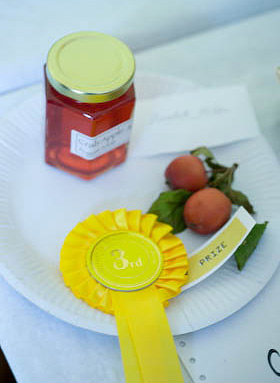
CRAB APPLE JELLY AT LAST YEARS VILLAGE SHOW
SPILT MILK AND MOTHBALLS
Wednesday July 30th 2008, 4:31 pm

We’ve had a few days of really hot weather and I never think to change the temperature of the fridge to compensate for the extra heat. Subsequently some milk started to go off. It was only a bit off, off enough so it tasted strange in tea. In an attempt to be resourceful and thrifty (not a quality that comes naturally to me) I set about turning it into something else. However I didn’t really think it through. I could have made some scones or added the milk to the mixture when making a chocolate cake but I messed up big time and ended up with a house that smelt disgusting and a dish of tasteless rubbery cheese that would have needed other things added to it to make it even vaguely palatable. I had wasted a good hour of my time and the ‘cheese’ went in the bin.
Perhaps it is just me, but the whole idea of making use of leftovers makes life feel grim and miserable. Just the word ‘leftovers’ is depressing. As the need to be more mindful of waste becomes increasingly necessary, someone needs to rework the subject to make it appealing. We need a new vocabulary that makes food scraps and stale stuff exciting.
While I was scrabbling around trying to find a use for my sour milk I found an old household encyclopaedia that I had collected primarily for its colourful dust jacket. Set out in an A to Z format, for sour milk it says:
SOUR MILK This is very good for polishing linoleum. It will remove iron rust from white fabrics.
So next time perhaps I’ll give that a go, not that I have any linoleum in the house. I spent quite some time reading through the book though, which is filled with useful nuggets of information as well as much that is quaint and outdated.
BED to ascertain if damp. Put a mirror for a few moments between the sheets. If it is misty when removed, then the bed is damp.
CHIMNEYS These can be kept reasonably clear of soot if potato peelings mixed with a little salt are burnt in the grate at least once a week. It will form a glaze inside the chimney and thus prevent its becoming clogged.
COFFEE GROUNDS Dry coffee grounds filled into a suitable covering make excellent pin-cushions; the pins and needles struck therein will never rust.
FLY-PAPERS to make. Take pieces of strong, thick paper, smear with treacle, and place in prominent positions. Always burn fly-papers after use.
(You just know your hair will become tangled up in one of these!)
HEDGEHOGS Keep in a cage during the day and release at night if it is desired to use them as beetle-catchers. Feed on bread and milk and an occasional earth-worm.
LAVENDER SACHET Mix together 75 parts powdered lavender, 20 parts powdered benzoin and 1 part oil of lavender.
(This actually sounds lovely and I think is worth trying out. Benzoin has a scent similar to vanilla so I imagine this combination would work beautifully.)
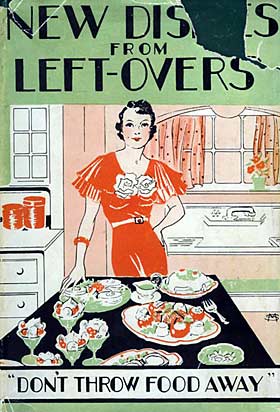
HOW NOW BROWN COW
Sunday July 27th 2008, 1:05 pm
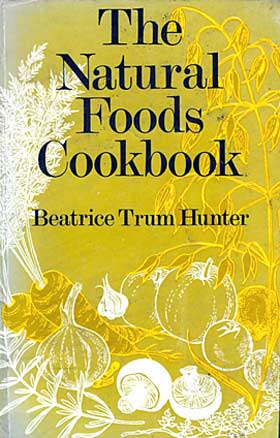
I became a vegetarian in 1972. Since then, at different times, I have explored veganism, followed a macrobiotic diet and been a pescatarian (is there such a word? an annoying vegetarian who happens to eat fish) but have only on one occasion knowingly eaten meat (too long a story!). I was never a great meat eater as a child so never felt I had made a huge sacrifice and it has never been my mission to convert others, I simply made a personal choice and that was that. It has never felt like a big deal but it was outside the mainstream, an approach that has always appealed to me.
In the years since 1972 I can’t tell you how many times I have been turned on at the dinner table by carnivorous strangers demanding I explain my reasons for not eating meat, or the times I have been with meat eaters discussing how every vegetarian they know looks pale, pasty and unhealthy. But I have always risen above it and it hasn’t bothered me. In 1972 it was difficult to eat out anywhere and find anything vegetarian on the menu and in subsequent years it has become much easier. I can remember some woman or other once saying to me ‘it wont kill you’ when I was querying whether a mushroom pizza had bacon on it and me, too shy to say boo to a goose, being embarassed. Most restaurants now offer at least one! meat-free option if not more and the ‘oh, you must eat nut roast then’ assumption has gladly gone. Meat eaters tend to be very concerned about how vegetarians get their protein.
On becoming a vegetarian, the first book I borrowed from the library was The Natural Foods Cookbook by Beatrice Trum Hunter (first published in 1963). This book includes chapters on meat and fish, but I remember feeling like I was reading a book written in a foreign language. So many of the ingredients were unknown to me, strange grains, weird pulses and vegetables that had never been seen in Lancashire where I grew up. But I was hungry for knowledge and lapped it all up, rereading and renewing this book from the library until I started to make sense of it all. Then, only specialist health food shops that were considered outside the loop stocked some of the ingredients. Seeking them out was also part of the challenge. I have just managed to find a copy on ebay and it is really interesting to assess how things have changed now these ingredients can be found in most supermarkets.
A while ago I was listening to a discussion on Radio 4 about animal rights. A young well-spoken woman made the point that humans are qualified to be considered superior beings because no animal has written a great work of literature. As far as I am aware no animal has written even a rubbish book but occasionally a dog manages to say ‘sausages’ as its party piece so perhaps we aren’t far away from a celebrity doggie chef.
More recently I have started to get annoyed. Annoyed enough that my being a vegetarian has started to matter. Whilst the interest in ethically reared and slaughtered meat improves the lives of animals, which is good, it feels like there is a real blokey, gung-hoe attitude attached. ‘Have you got the bottle to do the deed and slaughter your own meat?’ I like Hugh Fearnley-Whittingstall and loved his in-your-face-title for his book ‘Meat’, (it does what it says on the can), but when slaughtering animals becomes classed as TV entertainment it really depresses me. On his programme he featured a long-time vegetarian who wanted to eat meat again so was being taught how to butcher the carcass, WHY A VEGETARIAN? Gordon Ramsay, who regularly makes jibes about vegetarians also recently fed meat to a vegetarian stating that you must eat meat to follow a healthy diet and has on several occasions given animals reared for slaughter witty names of other celebrity chefs. In the TV listing for the next ‘F Word’ programme, ‘Janet Street-Porter serves veal calves to 50 vegetarians keen to eat meat again!’ I am starting to wonder whether we are being fed propaganda by the Meat Marketing Board, or whatever it is called these days. What’s with all these conversions?
The fact of the matter is that we have a multitude of choices in the west of what we eat. We can live perfectly healthily without meat if we want too. So it is really refreshing when you come across a book like ‘Wild Garlic, gooseberries….. and me’ by Denis Cotter. This book gives me faith that for some, things have moved on in an inspiring and intelligent way. Denis writes about his ingredients so beautifully that in comparison, calling a pig Anthony Worral-Thompson seems pure trailer trash. And strangely, seeing my book from the 70’s beside Denis Cotter’s book there is something not dissimilar about the jackets.

HOW TO STOP YOURSELF FROM BUYING A BOOK
Saturday March 01st 2008, 2:29 pm
I almost bought How To Cheat At Cooking, Delia’s new book today. I picked it up in the supermarket and it was the first opportunity I had had to look inside. In fact it is a really lovely book, the feel of it, the style of it and the colour of it, all appeals to me. The photography is lovely and the type of food is just what I like. The book did get as far as the check-out in my trolley before I managed to abandon it, but it was a tussle. I feel that the only way to form a rational opinion about the book is to buy it and if it wasn’t Delia I wouldn’t care.
I did try to have a quick look at the recipes and noticed a quiche that you assemble using amongst other things, ready-cooked bacon pieces. That must save you all of ten valuable minutes. I can hear the complaints now from the quick-fix generation, that they have to wait 30 minutes for the quiche to cook. Perhaps a sandwich would be quicker. Can you buy ready buttered bread? Actually did you know that you can use mayonnaise from a jar instead of making it yourself? I didn’t read that in the book but thought of it all by myself.
How To Cheat At Cooking would make a good all round, day to day recipe book if only it told you the how not-to-cheat recipe alongside the ‘how to cheat’ version. In fact I don’t really understand why they didn’t arrange the format in that way because then everyone would have been happy. Of course like most people, I am capable of making the conversion myself but presumably the people who the book is aimed at aren’t able to do this the other way round.
This week I found my old copy of ‘Frugal Food’, Delia’s book from 1976. I think we are all allowed to change our minds over the years but I couldn’t help noticing her statement that ‘ instant foods cost a fortune’. An excerpt from the book: ‘Actually I’m not so sure that all this time-saving really does save time. I once watched a lady standing in a long check-out queue with just a large bag of frozen brussels sprouts (they were at the time 30 per cent dearer than the fresh ones). She was In the queue for a good 10 or 12 minutes; she could, had she wished, have sat in her own kitchen and peeled fresh brussels sprouts in the same time.’
Obviously before online shopping.
HOW TO PEEL A POTATO
Sunday February 17th 2008, 2:02 pm
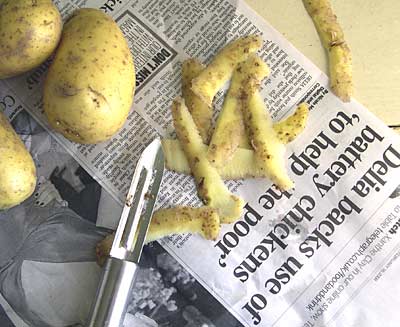
The other day I was watching a food programme on Sky 3 called Taste. They were doing a feature about what to ‘cook’ for a girlie night in using ready-made food and the presenter came out with the phrase, ‘I’m not suggesting you peel a potato’. I almost choked on hearing this and the words have been going round in my head ever since. God forbid, anyone should peel a potato and to suggest such a thing…well! Once upon a time life was too short to stuff a mushroom, now it’s too busy to peel a potato.
Yesterday I bought the Saturday papers including a paper with a feature about Delia and her upcoming new TV series and book, How To Cheat At Cooking, where she will be using pre-prepared bought-in ingredients, such as ready-made mashed potatoes, cook-in sauces and other ingredients that need to be hyphenated, to rustle up lovely meals in a moment. This is aimed at busy people who don’t have much time and are also quite poor so need to eat battery farmed chickens (quite obviously a distortion of the facts, in a nutshell, based on what I have read in the paper, Chinese-whispers-stylee, pass it on!). There are bound to be many words written about her and the series in the weeks ahead as she holds such an iconic status here in the UK and this series is her comeback, having retired from cookery writing 6 years ago to concentrate on her career as a footballer.
I must admit I hold her in the highest esteem myself, having learnt to cook with her. When I lived in two places I made sure the 3 part cookery course (the first time round version) and her Summer Collection were duplicated, one in each home, as I consider them to be ‘must haves’. I know many of the recipes especially from her earlier books by heart and on numerous occasions Delia recipes have been served up at momentus family gatherings. A sort of mythical Delia inhabits my families consciousness. She has an uncanny knack of being ahead of the game, like she just knows something the rest of us are struggling to put our finger on, but I am feeling very wobbly about this new theme she has embraced.
I am not a particular fan of the ‘quick and easy’ route to anything, just for the sake of it. Some things simply are quick and easy and still work brilliantly and that’s great, but there is something at the core of this that bothers me. I think we’ve got an obsession with being busy people. Most of us ARE busy, that’s a given, but the cult of busy is about making ourselves feel significant by banging on about how busy we are all the time. There is a huge industry out there catering for our busy lives and that relies on us buying into being really ‘busy people’. What came first, the chicken or the egg?
Go on, step outside the box. Find the time to peel a potato. Upend the cliche.






